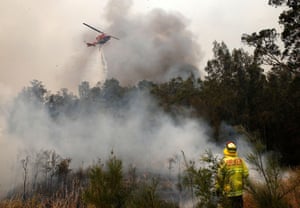SYDNEY, Nov 13 (NNN-AGENCIES) – Fire crew remained on high alert, in eastern Australia today (Wednesday), despite more favourable conditions in the bushfires, affecting the State of New South Wales (NSW).
State capital, Sydney, emerged largely unscathed from Tuesday’s “catastrophic” fire danger, with winds and temperatures easing, to provide much needed respite for firefighters and communities. So far, the three people killed last week remain the only reported casualties caused by the tragedy.
However, a number of regional parts of NSW experience widespread fire damage, with early reports suggesting around 50 homes were lost.
Firefighters dedicated efforts and cooperation of residents are being credited with preventing what could have been a far more devastating outcome.
Emergency management expert and General Manager of Resilience at Risk Frontiers, Andrew Gissing, said that, Tuesday’s relative success relied on firefighter’s ability to rapidly extinguish new fires before they spread out of control.
Water bombing aircraft were used to tackle several blazes close to metropolitan Sydney, including an area in the city’s northern suburbs, where a diverted plane dumped pink-dyed flame retardant to extinguish a fire which was threatening homes.
On the ground, fire crew, many of whom were volunteers, arrived quickly to defend hundreds of properties across the state.
The logistics of coordinating thousands of ground crew and resources, in the face of an ever changing threat, resembles something like fighting a war, Gissing said.
Evacuation centres are established across the state, providing temporary shelter to hundreds of displaced people.
“Some of these people have had their houses burnt down and they had to go with the clothes they have. So the community as a whole, has very graciously donated items, clothes, bedding, toothpaste,” evacuation centre organiser, Morgan Stewart said.
One of the great challenges faced by those trying to save lives in a bushfire emergency is the decision by some to ignore authorities’ advice to leave, and instead stay and hope for the best, a strategy which can quite quickly become fatal.
“On days like yesterday where people are urged to leave early, some people might still stick around, just to see how it turns out,” Gissing said.
Last week, among the three fatalities was a person found dead in their vehicle, killed while trying to escape oncoming flames. Adverse conditions are expected to continue across Australia throughout the week, with authorities again urging everyone not to become complacent, as the threat could easily, and very quickly, ignite once more.
“Unfortunately, what we need is rain,” Rural Fire Service Commissioner, Shane Fitzsimmons, told reporters.
“What we need is meaningful rain. And there is certainly nothing in the forecast for the foreseeable future that’s going to make any discernible difference to the conditions that we are experiencing,” Fitzsimmons said.– NNN-AGENCIES






